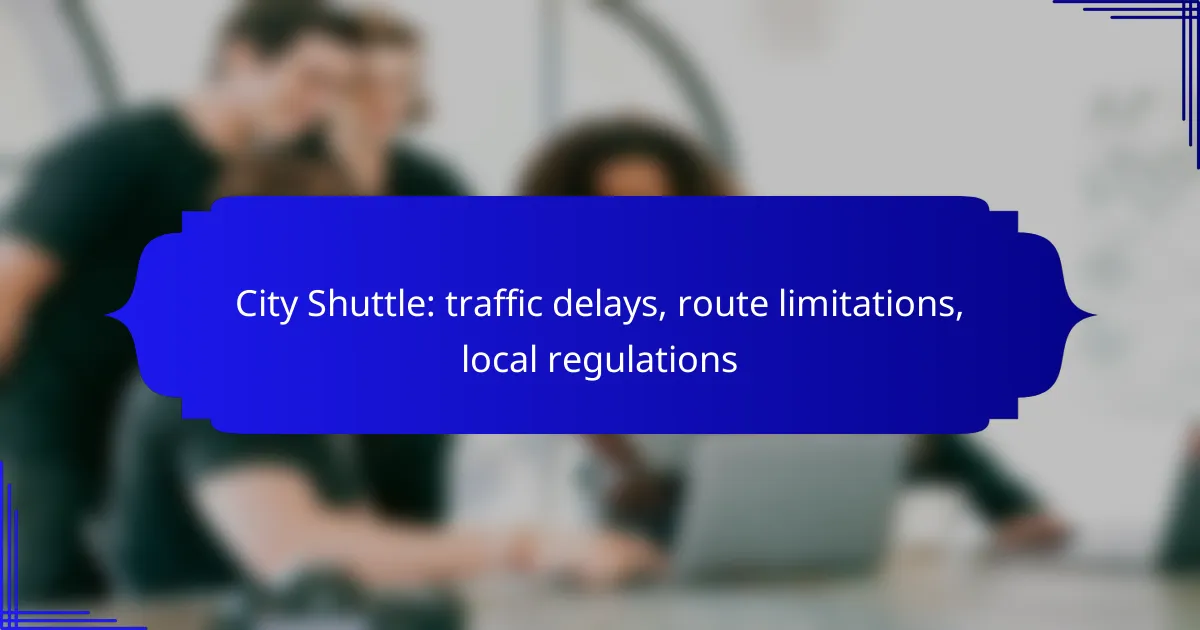City shuttles in London are essential for navigating the urban landscape, but they often encounter traffic delays and route limitations due to local regulations. To optimize your travel experience, it’s important to stay informed about real-time traffic conditions and the specific rules governing shuttle operations, such as congestion charges and restricted zones. By planning accordingly, you can minimize delays and enhance the efficiency of your commute.
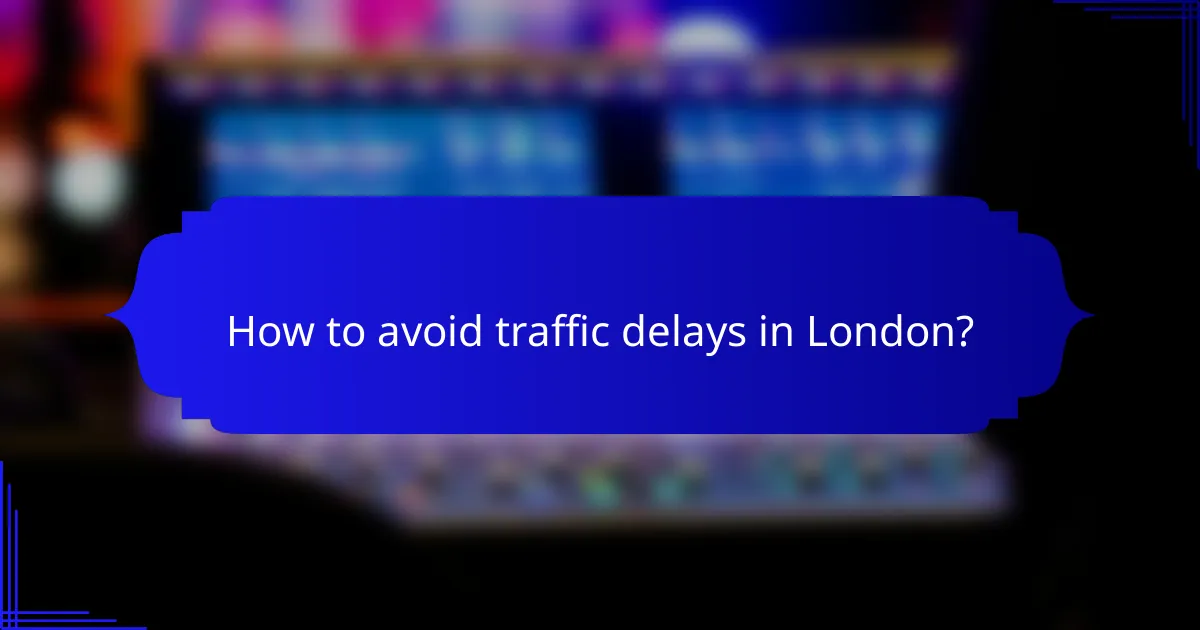
How to avoid traffic delays in London?
To avoid traffic delays in London, utilize real-time traffic information and plan your travel during less congested times. Understanding local traffic patterns and regulations can significantly enhance your commuting experience.
Use real-time traffic apps
Real-time traffic apps provide up-to-date information on road conditions, accidents, and delays. Popular options like Google Maps and Waze can help you navigate around congested areas by suggesting alternative routes.
These apps often include features that alert you to traffic incidents and estimated arrival times, allowing you to make informed decisions on your travel. Regularly checking these apps before and during your journey can save you valuable time.
Plan routes during off-peak hours
Traveling during off-peak hours can significantly reduce the likelihood of encountering traffic delays in London. Typically, peak hours are weekdays from 7 AM to 9 AM and 4 PM to 6 PM, so planning your trips outside these times can lead to smoother travel.
Consider scheduling appointments or errands for mid-morning or early afternoon when traffic is lighter. Additionally, using public transport options during these hours can further minimize delays and enhance your overall travel efficiency.

What are the route limitations for city shuttles in London?
City shuttles in London face several route limitations that can affect their efficiency and accessibility. These limitations include restricted zones, bus lane regulations, and local traffic regulations that must be adhered to for smooth operations.
Restricted zones in Central London
Central London has designated restricted zones where city shuttles may face entry limitations. These areas are typically marked by signs indicating the Ultra Low Emission Zone (ULEZ) and Congestion Charge Zone, which require vehicles to meet specific emissions standards or pay a fee to enter.
Shuttle operators should be aware of these zones to avoid fines and ensure compliance. Planning routes that circumvent these areas can help maintain service efficiency while adhering to local regulations.
Bus lane regulations
City shuttles are allowed to use certain bus lanes during specified hours, which can significantly reduce travel time. However, these regulations can vary by location and time of day, so it’s essential for shuttle services to stay updated on local bus lane rules.
Operators should monitor the signage along routes to ensure they are using bus lanes correctly. Ignoring these regulations can lead to penalties and delays, impacting overall service reliability.
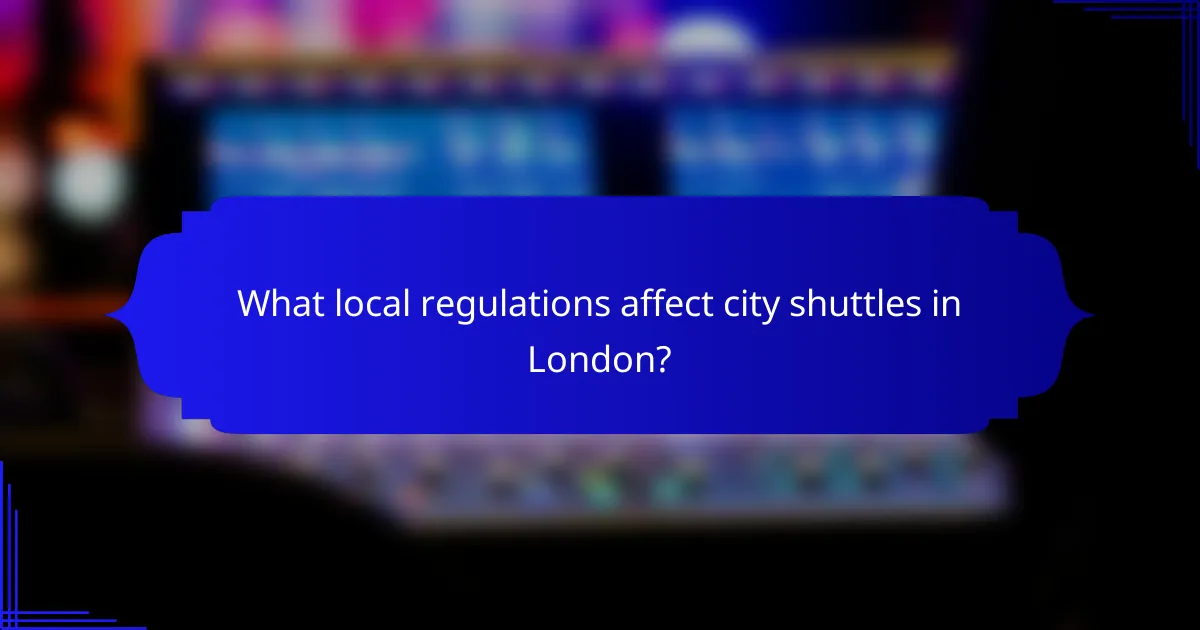
What local regulations affect city shuttles in London?
City shuttles in London are subject to various local regulations that impact their operation, including the congestion charge and environmental zone compliance. Understanding these regulations is crucial for shuttle operators to avoid penalties and ensure smooth service.
London congestion charge
The London congestion charge is a fee charged to vehicles operating within designated areas of central London during peak hours. This charge aims to reduce traffic congestion and encourage the use of public transport.
Shuttle operators must register their vehicles and pay the congestion charge to avoid fines. The daily charge typically applies from 7:00 AM to 10:00 PM on weekdays, and the fee can vary, so it’s essential to check the latest rates on the Transport for London (TfL) website.
Environmental zone compliance
London’s Ultra Low Emission Zone (ULEZ) requires vehicles to meet strict emissions standards to operate within the zone without incurring additional charges. This regulation is designed to improve air quality and reduce pollution in the city.
Shuttle services must ensure their vehicles comply with ULEZ standards, which may involve upgrading to newer, cleaner models or paying a daily charge for non-compliant vehicles. Operators should regularly review their fleet’s emissions status and stay informed about potential changes to regulations.

How to choose the best shuttle service in London?
To choose the best shuttle service in London, consider factors like service reviews, pricing structures, and route limitations. Evaluating these aspects will help you find a reliable and cost-effective option that meets your travel needs.
Compare service reviews
Start by checking online platforms for customer reviews of various shuttle services. Websites like Trustpilot or Google Reviews can provide insights into the reliability and quality of service offered by different companies.
Look for services with consistently high ratings and positive feedback regarding punctuality, vehicle condition, and customer service. Pay attention to any recurring issues mentioned by users, as these can indicate potential problems.
Evaluate pricing structures
Shuttle service pricing in London can vary widely based on distance, time of day, and type of service. Some companies offer fixed rates for specific routes, while others may charge by the mile or minute.
Compare prices across several providers, keeping an eye out for hidden fees such as booking charges or extra costs for luggage. Consider whether the service offers discounts for round trips or group bookings, which can help you save money.
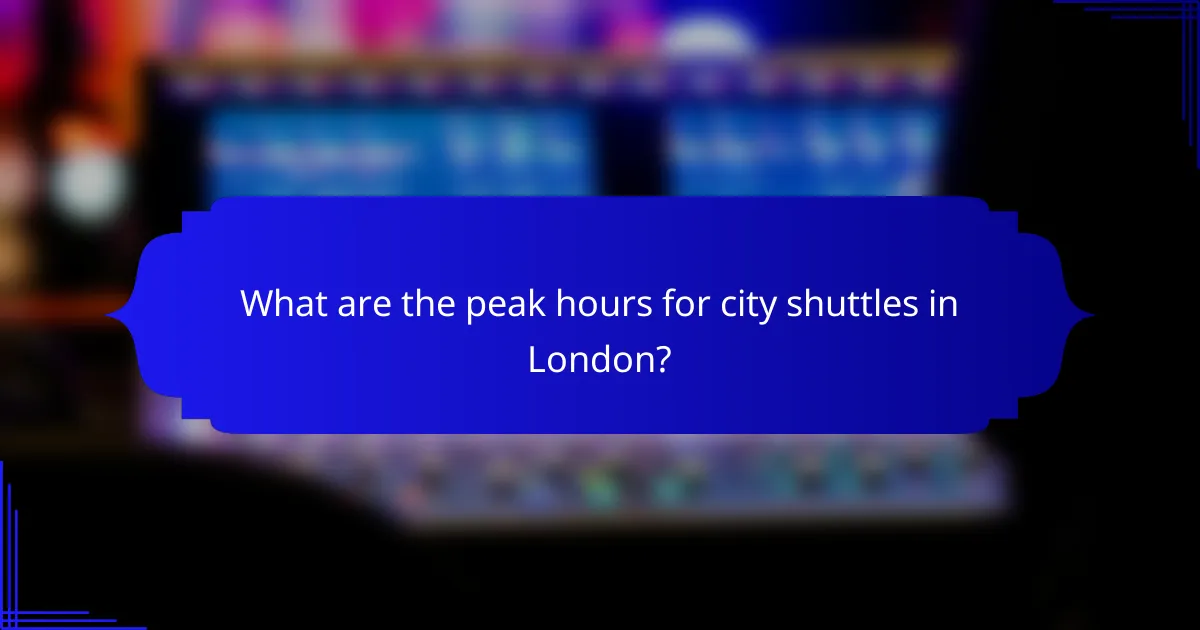
What are the peak hours for city shuttles in London?
Peak hours for city shuttles in London typically occur during weekday mornings and evenings when commuter traffic is at its highest. Understanding these times can help passengers plan their journeys more efficiently and avoid delays.
Weekday morning rush hours
Weekday morning rush hours in London generally span from around 7:00 AM to 9:30 AM. During this time, shuttles experience significant demand as commuters travel to work or school.
Passengers should expect longer wait times and crowded shuttles. It’s advisable to plan for potential delays and consider leaving earlier if possible to ensure timely arrivals.
Evening commute times
Evening commute times for city shuttles in London usually peak between 4:30 PM and 7:00 PM. This period sees a high volume of passengers returning home from work.
Similar to the morning rush, shuttles may be delayed due to traffic congestion. To avoid the busiest times, consider traveling slightly before or after these peak hours if your schedule allows.
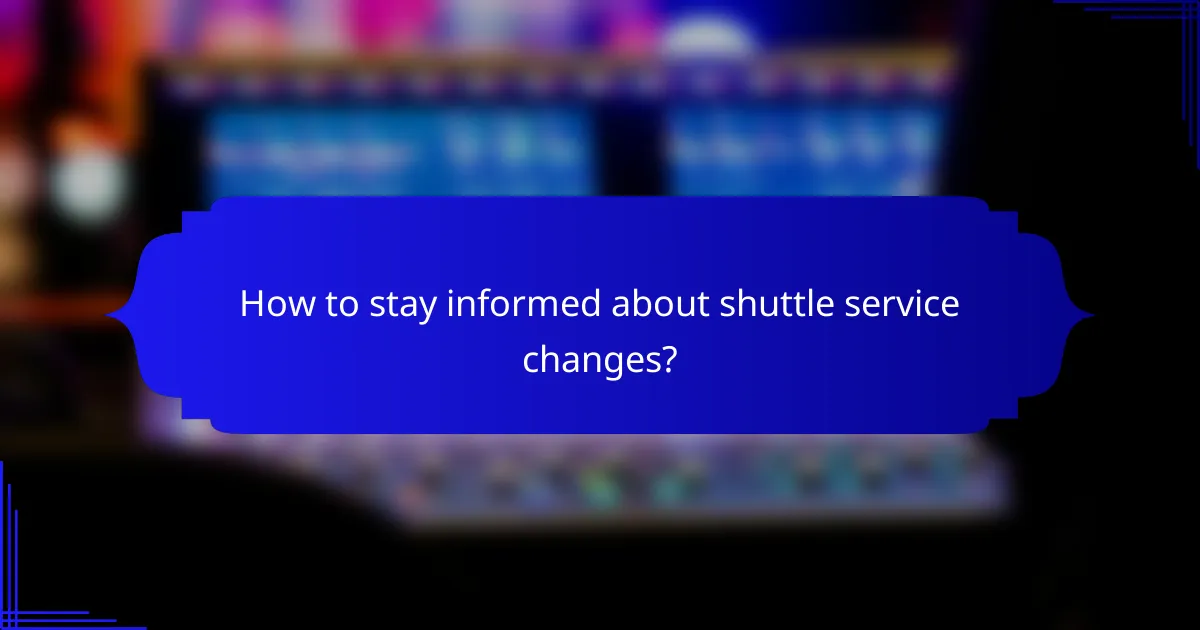
How to stay informed about shuttle service changes?
To stay informed about shuttle service changes, regularly check official sources and subscribe to updates. This ensures you receive timely information on traffic delays, route limitations, and any local regulations affecting shuttle operations.
Follow local transport authority updates
Local transport authorities often provide real-time updates on shuttle services through their websites and social media channels. These updates may include information on traffic delays, detours, and service interruptions. Regularly visiting these platforms can help you plan your travel more effectively.
Many transport authorities also have mobile apps that send push notifications for service changes. Downloading these apps can provide immediate alerts, allowing you to adjust your plans as needed.
Subscribe to shuttle service newsletters
Subscribing to newsletters from shuttle service providers is an effective way to receive direct updates. These newsletters typically include information about upcoming changes, special promotions, and service enhancements. Look for options to receive alerts via email or SMS for the most convenient access.
When subscribing, ensure you select preferences that align with your travel needs, such as specific routes or service areas. This way, you can receive tailored information that is most relevant to your daily commute.
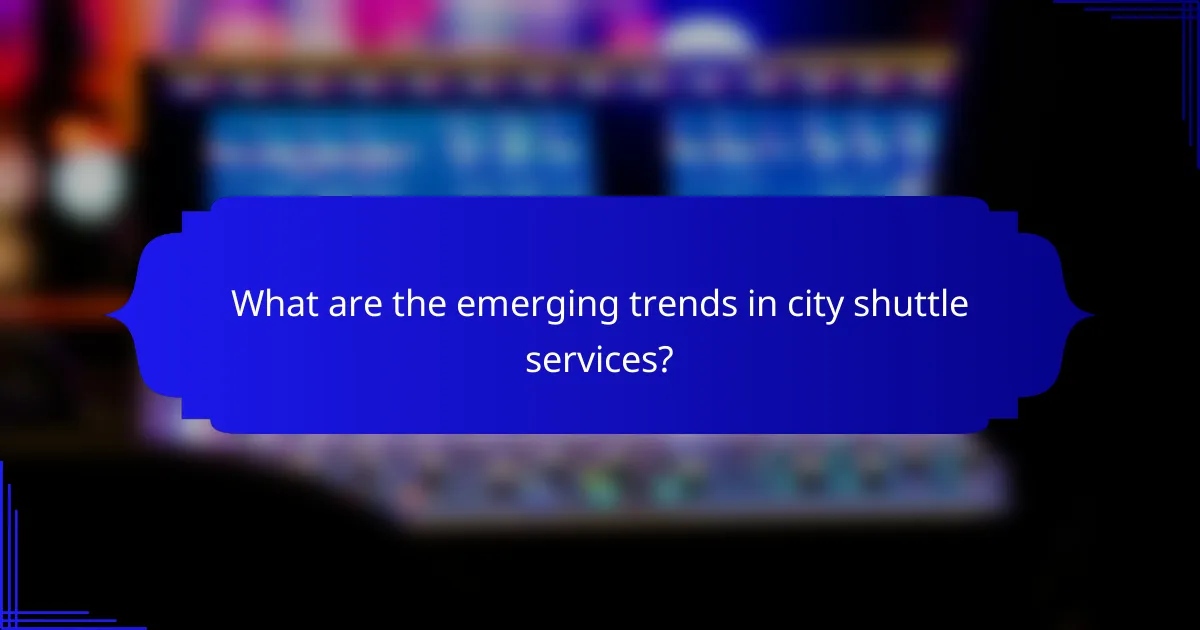
What are the emerging trends in city shuttle services?
Emerging trends in city shuttle services include the integration of electric vehicles, enhanced digital platforms for real-time tracking, and a focus on sustainability. These trends aim to improve efficiency, reduce environmental impact, and enhance user experience in urban transportation.
Integration of electric vehicles
The integration of electric vehicles (EVs) in city shuttle services is gaining momentum as cities aim to reduce carbon emissions and promote cleaner transportation options. EVs offer lower operating costs and can significantly decrease noise pollution, making them ideal for urban environments.
Many cities are implementing incentives for shuttle services to transition to electric fleets, such as grants or tax breaks. For instance, municipalities may provide funding to cover the initial costs of EVs or charging infrastructure, which can help offset the investment burden for shuttle operators.
When considering the integration of electric vehicles, shuttle services should evaluate factors such as charging station availability, battery range, and maintenance requirements. Operators should also stay informed about local regulations and incentives related to electric vehicles to maximize benefits.
